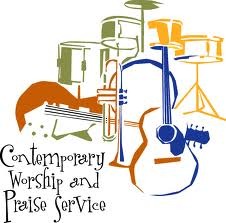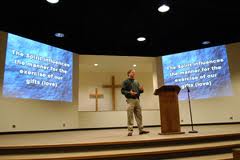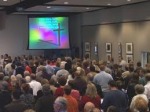A Contrast In Styles

 Recently I attended a funeral at an old established church. When entering the foyer to the right was what use to be a gymnasium, now packed with hundreds of chairs, with a drum set and microphones on the front stage. This was for the “contemporary” service. The funeral was in the “sanctuary” with its pews, altar, split pulpits, huge hanging cross suspended from the ceiling, side wedding chapel and full pipe organ. This was the home of the “traditional” service.
Recently I attended a funeral at an old established church. When entering the foyer to the right was what use to be a gymnasium, now packed with hundreds of chairs, with a drum set and microphones on the front stage. This was for the “contemporary” service. The funeral was in the “sanctuary” with its pews, altar, split pulpits, huge hanging cross suspended from the ceiling, side wedding chapel and full pipe organ. This was the home of the “traditional” service.
 It made me think of the diversity in the body of Christ. Even within a local church context there was division over personal preference, basically over styles of music and order or worship. The older crowd, who strongly supports the edifice financially, prefers the “Old Rugged Cross”, “How Great Thou Art”, and “It Is Well With My Soul” over contemporary chorus, who would rather read a liturgy from the back of a hymnal than a projected overhead slide. Meanwhile the younger “contemporary” crowd enjoys the flexibility of folding chairs over pews, and repetitive choruses over lengthy five verse hymns in King James English, and the high tech video clips.
It made me think of the diversity in the body of Christ. Even within a local church context there was division over personal preference, basically over styles of music and order or worship. The older crowd, who strongly supports the edifice financially, prefers the “Old Rugged Cross”, “How Great Thou Art”, and “It Is Well With My Soul” over contemporary chorus, who would rather read a liturgy from the back of a hymnal than a projected overhead slide. Meanwhile the younger “contemporary” crowd enjoys the flexibility of folding chairs over pews, and repetitive choruses over lengthy five verse hymns in King James English, and the high tech video clips.

 What they had in common is volume: “traditional” pipe organ preludes echoing off the walls with resounding vibrations, or “contemporary” choruses with more electric bass and pounding drums through a high quality sound system. The only thing that was the same in both services is the sermon; amazingly, the same sermon to different audiences! Styles of music and worship have changed with its audience, but not the presentation of the Word by the senior pastor or staff member, and in both services the clergy let the congregation know that the delivery of the Word transcended over they styles of worship present.
What they had in common is volume: “traditional” pipe organ preludes echoing off the walls with resounding vibrations, or “contemporary” choruses with more electric bass and pounding drums through a high quality sound system. The only thing that was the same in both services is the sermon; amazingly, the same sermon to different audiences! Styles of music and worship have changed with its audience, but not the presentation of the Word by the senior pastor or staff member, and in both services the clergy let the congregation know that the delivery of the Word transcended over they styles of worship present.
 In spite of differences in musical taste and presentation, neither service still allowed its worshipers, those in the congregation, to be the initiators of corporate worship. Worship leaders and choir directors with liturgists still lead the worship. The congregation was always asked to “follow” never to “lead” worship. Worship never originated from those in the pews or folding chairs. Both allowed you to give financially through your tithe and offering, and sing along with the pipe organ or worship band, and to greet one another informally with a hand shake and a “God bless you,” but never gave the worshiper an opportunity to give a testimony of their living faith, to read scripture that inspired them through their private devotions that came alive in their daily walk, nor a time to pray with one another or minister to one another.
In spite of differences in musical taste and presentation, neither service still allowed its worshipers, those in the congregation, to be the initiators of corporate worship. Worship leaders and choir directors with liturgists still lead the worship. The congregation was always asked to “follow” never to “lead” worship. Worship never originated from those in the pews or folding chairs. Both allowed you to give financially through your tithe and offering, and sing along with the pipe organ or worship band, and to greet one another informally with a hand shake and a “God bless you,” but never gave the worshiper an opportunity to give a testimony of their living faith, to read scripture that inspired them through their private devotions that came alive in their daily walk, nor a time to pray with one another or minister to one another.
We have produced another “great divide” on our churches, even at the local level, in this case because of age preferences, traditions, and styles of worship and music. We have allowed two different congregations to be established under the same physical roof: an aged one dwindling due to a dying population but still rich with tradition meaningful to their spiritual walk, and a younger one establishing their traditions they eventually will want to hold on to as they age. It amazes me that we preach about the “unity of the Body of Christ”, yet the church is one of the most segregated institutions in our society because of race, age, and culture. We seem not to welcome diversity in our worship experiences, but segregate it instead.
What would happen if we allowed the worship to flow out of those attending? If “new songs” actually originated from within them but shared with all? If scripture from the Bible, the Logos Word, would be shared and actually activated by them into the Rhema, or Living Word, in the midst of all who are worshiping? If those worshiping actually “anticipated” the Holy Spirit to arise in and among them individually and corporately rather than follow the safety of a planned out experience? If those attending would actually feel accountable for anything and everything happening in a service or all would just sit in silence until the Holy Spirit moved? Where life would flow out of those attending the service toward one another?

 Instead we opt for our own selfish preferences, what pleases me, what I like, what I seek, what would best benefit me, and those in my family! That is the independent spirit that crushes “body ministry”. Christianity is about giving out, sending out, the flowing outwardly of our inner faith. It is not about “us” but about Jesus to a dieing, hurting, suffering, hungry, lonely, sick world. When we encourage our Christian believers to “reach” deep within themselves to find Jesus, we then have to give an opportunity for our Christian believers to be “sent out” and “flow out” of that faith that is deep within them and reveal Jesus to the world and to each other. What better place to practice that than in the safety of our own Church fellowship and gathering. That place should be a place of worship, a place of releasing, a place of giving, a place of flowing.
Instead we opt for our own selfish preferences, what pleases me, what I like, what I seek, what would best benefit me, and those in my family! That is the independent spirit that crushes “body ministry”. Christianity is about giving out, sending out, the flowing outwardly of our inner faith. It is not about “us” but about Jesus to a dieing, hurting, suffering, hungry, lonely, sick world. When we encourage our Christian believers to “reach” deep within themselves to find Jesus, we then have to give an opportunity for our Christian believers to be “sent out” and “flow out” of that faith that is deep within them and reveal Jesus to the world and to each other. What better place to practice that than in the safety of our own Church fellowship and gathering. That place should be a place of worship, a place of releasing, a place of giving, a place of flowing.
We need to rethink how we do “church” at “church” when the “church” gathers if we are really God’s “church”!